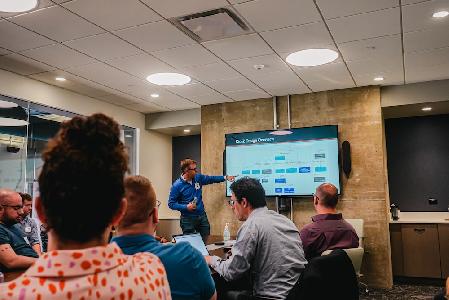Drexel University professor and researcher Andrew Cohen was part of an interdisciplinary research project that broke scientific ground this week. His 10-person team made the best-ever 3D microscopic videos of organelles in a live cell.
(Before you keep reading: what are organelles? It’s ok, we didn’t know either. Organelles are the super tiny specialized structures that makeup each cell in your body. Names that may ring a bell from biology class are the mitochondria and the Golgi apparatus.)
The study, published Wednesday in scientific journal Nature, details how the team made the visualizations possible through a series of microscopic techniques. While there have been similar videos made before, these offer a previously unavailable level of clarity and detail.
Backed by the National Institute of Health and the Howard Hughes Medical Institute, the research team features prominent cell researcher Jennifer Lippincott-Schwartz and Eric Betzig, the 2014 Nobel Prize winner for chemistry.
Systems-level spectral imaging and analysis have been applied to reveal the organelle interactome https://t.co/jQKB8wakUF pic.twitter.com/nCEcL29YYS
— Nature Portfolio (@NaturePortfolio) May 29, 2017
The computational analysis for the study was done at Drexel, with Cohen’s Computational Image Sequence Analysis Lab at the forefront. In basic terms, the team applied an in-house image tracking algorithms to automate the identification and tracking of the very tiny organelles.
Here’s one of the mind-blowing videos in time-lapse:
And here’s another, focusing on six specific organelles separately:
So, for the scientific perspective, why does Cohen feel the study is relevant?
“Goodness gracious!” Cohen said. “This is an indication of where we’re going. It’s an indication of the promise of bringing together biology, microscopy and computational groups. The ability to combine these elements lets biologists see what they couldn’t see before. It’s an unprecedented view inside the living cell.”
Cohen thinks the study is also great for Philly, where the biology community is sizable thanks to anchor institutions like Drexel and the University of Pennsylvania.
As with all dense scientific studies, the question from the average layman is: what’s the practical application? Stem cell research and cancer therapy are two areas where the new technique might be impactful down the line, Cohen said.
“[The biggest impact] is being able to observe the cells’ behaviors over time and quantify it in a way that helps us gain insight into how normal cells are expected to develop, at what time they change when there’s a disease,” Cohen said.
In a follow-up paper to come later this year, Cohen will be detailing the tools used to create the visualizations and will be releasing them as open source to the entire scientific community.
Join the conversation!
Find news, events, jobs and people who share your interests on Technical.ly's open community Slack

Philly daily roundup: Student-made college cost app; Central High is robotics world champ; Internet subsidy expiration looms

Philly daily roundup: Earth Day glossary; Gen AI's energy cost; Biotech incubator in Horsham

Philly daily roundup: Women's health startup wins pitch; $204M for internet access; 'GamingWalls' for sports venues

